Hosting Quota Notifications 1.X For WHMCS
About Multibrand For WHMCS
| Multibrand For WHMCS will allow you to manage multiple brands on multiple websites while using just a single WHMCS installation.
You will be able to customize your brand through modifying factors like client area template, logo or brand language, and preview the changes with just a single click. |
- Addon Features:
| ✔ User Friendly Management Of Multiple Brands |
| ✔ Easy Modification Of Existing Brands |
| ✔ Assign/Unassign Clients To Multiple Brands |
| ✔ Assign Products To Brands |
| ✔ Assign Product Bundles To Brands |
| ✔ Assign Ticket Departments To Brands |
| ✔ Configure Payment Gateways For Each Brand Separately: |
| ✔ PayPal - Single Payment And Subscription |
| ✔ 2CheckOut - Single Payment Only |
| ✔ Display Active Clients, Invoices, Orders, Tickets And Services Associated To Brands |
| ✔ Quick Preview Of Branded Client Area |
| ✔ Publish/Unpublish Brands On Click |
| ✔ Set Brand As Default - Automatic Assignment Of New Clients |
| ✔ View Brand Reports - List Of Clients, Invoices, Orders, Tickets And Services |
| ✔ View Dynamic Brands Comparison Reports - Various Graph Types |
| ✔ Generate Separate Email Templates For Each Brand |
| ✔ Verify Integration Of Templates Used By Brands |
- Admin Area Features:
| ✔ Order Branded Products |
| ✔ Create Branded Invoices |
| ✔ Create Branded Quotes |
| ✔ Open Branded Tickets |
| ✔ Create Branded Announcements |
| ✔ Add Branded Knowledgebase Articles |
| ✔ Add Branded Downloads |
| ✔ Log In As Client To Chosen Brand |
- Client Area Features:
| ✔ Displayed Client Area Template And Default Language Depend On Brand |
| ✔ Access To Products, Invoices, Downloads, Ticket Departments and Payment Gateways Assigned To Brand |
| ✔ View Articles And Announcements Assigned To Brand |
| ✔ Receive Branded Emails And Invoices |
| ✔ Branded Clients Can Only Log Into Brand They Are Assigned To |
| ✔ Multibranded Clients Can Log Into All Existing Brands With The Same Access Details |
- Brand Configuration:
| ✔ Default Brand For New Accounts |
| ✔ Brand Name |
| ✔ Company Name |
| ✔ Brand URL Address |
| ✔ Brand Logo |
| ✔ Brand Language |
| ✔ Brand Template |
| ✔ Brand Address |
| ✔ Brand Signature |
| ✔ Brand Email |
| ✔ Brand Graph Color |
| ✔ Brand Terms Of Service URL |
- General Info:
| ✔ Multi-Language Support |
| ✔ Supports PHP 5.4 Up To PHP 7 |
| ✔ Supports WHMCS Templates Five and Six |
| ✔ Supports WHMCS V6 and V7 |
Installation
| This tutorial will show you how to successfully install and configure Multibrand For WHMCS. We will guide you step by step through the whole installation and configuration process. |
Installation
| 1. Log in to your client area and download the module. |
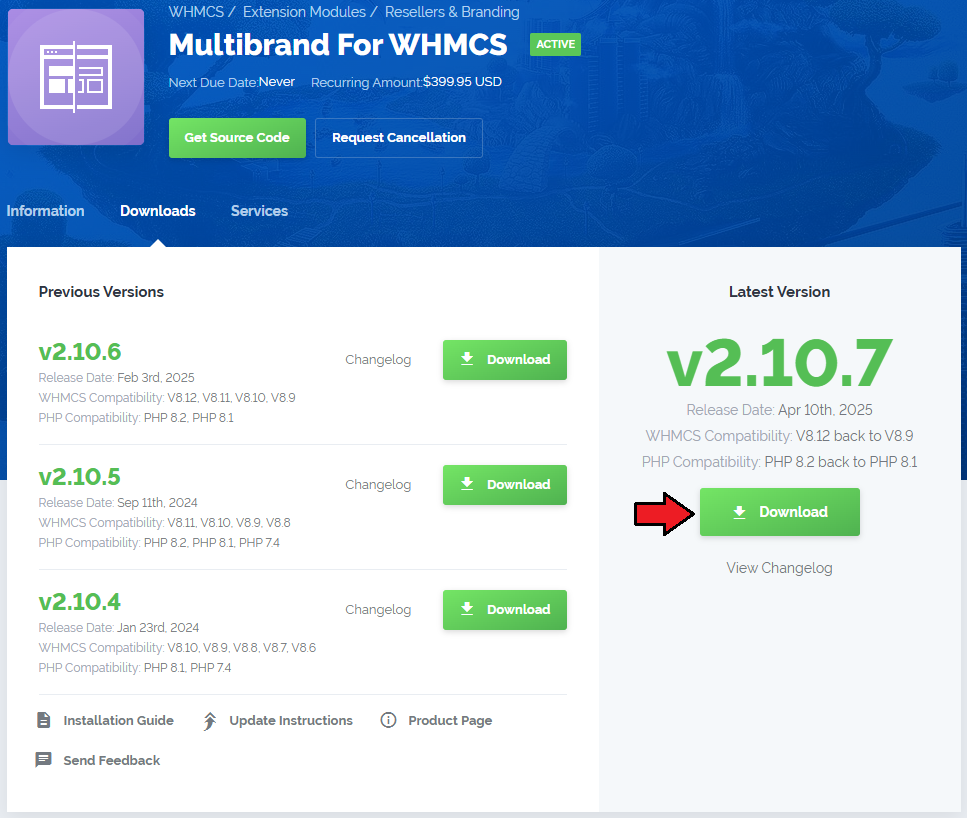
|
| 2. In the downloaded file you will find two packages that support different PHP versions. As presented on the screen below, the first one is dedicated to PHP 7, while the second one is aimed at PHP 5.4 up to PHP 5.6. It does not apply to open source versions. Note: You can check current PHP version in your WHMCS. To do so proceed to 'Utilities' → 'System' → 'PHP Info'. |

|
| 3. Extract the downloaded file and choose the one with the right PHP version. Upload and extract the PHP file into the main WHMCS directory. The content of PHP version files should look like this. |

|
| 4. When you install Multibrand For WHMCS for the first time you have to rename 'license_RENAME.php' file. File is located in 'modules/addons/MultibrandFunctionality/license_RENAME.php'. Rename it from 'license_RENAME.php' to 'license.php'. |
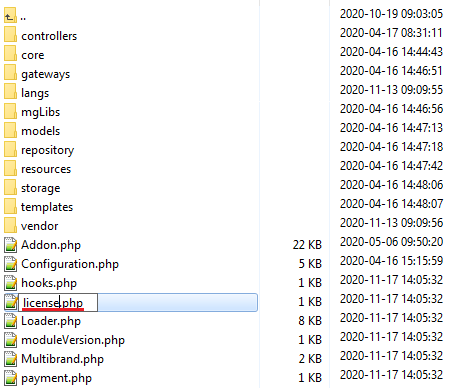
|
| 5. In order to configure your license key, you have to edit a previously renamed 'license.php' file. Enter your license key between quotation marks as presented on the following screen. You can find your license key in your client area → 'My Products'. |

|
Activating Addon Module
| 6. Now you have to activate the module in your WHMCS system. Log in to your WHMCS admin area. Go to 'Setup' → 'Addon Modules'. Afterwards, find 'Multibrand' and press 'Activate' button. |
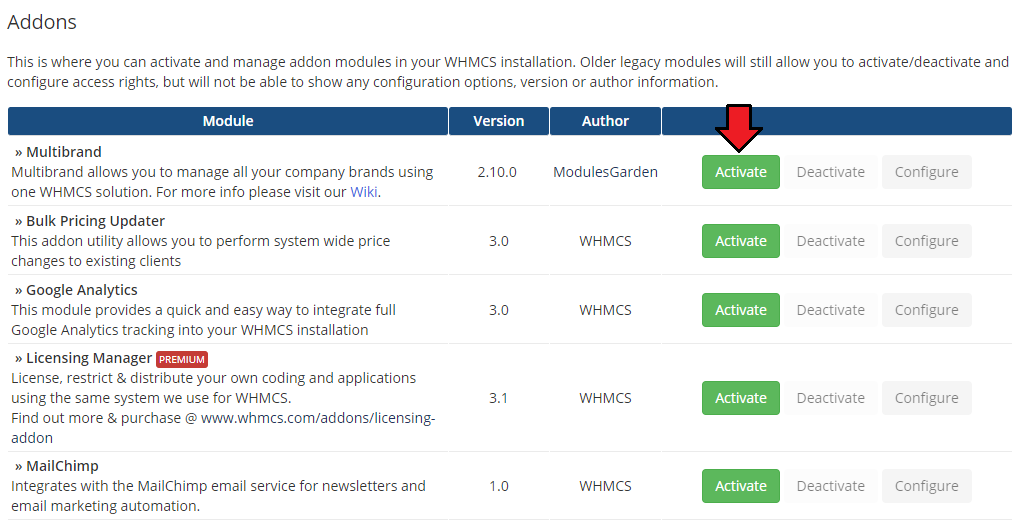
|
| 7. In the next step you need to allow to hooks beeing enabled and permit access to this module. To do so click on 'Configure' button, tick 'Access Control' near required admin role groups and press 'Save Changes'. |
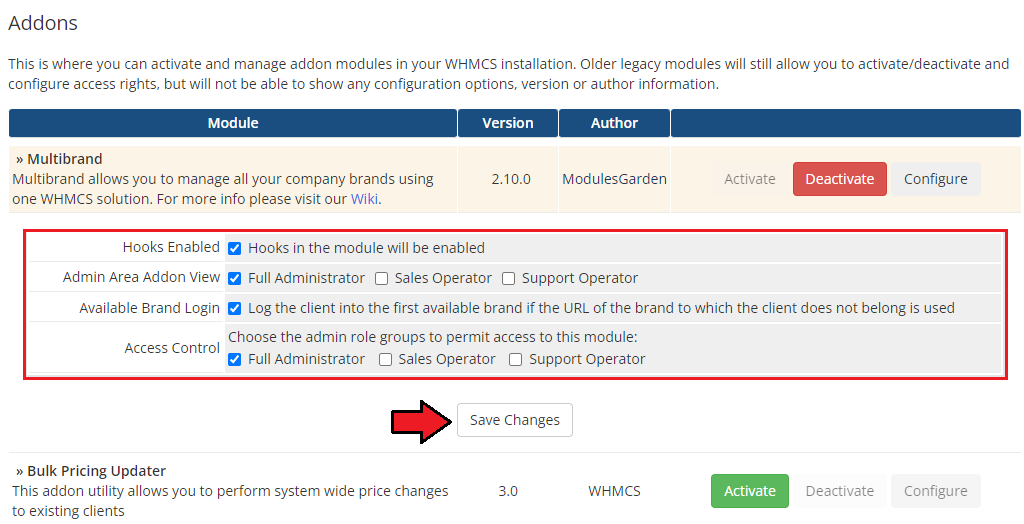
|
Additional Settings
| 8. Now, set up the 'storage' folder as recursively writable (with all subfolders). This folder are located in 'your_whmcs/modules/addons/Multibrand/' location. |
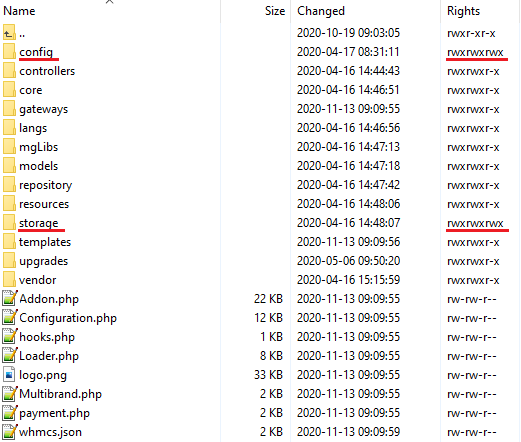
|
| 9. You will also need set up 'gateways' and 'callback' folders as writable. This folders are located in 'your_whmcs/modules/' and 'your_whmcs/modules/gateways accordingly locations (do NOT mistake with the in the Multibrand addon location) |
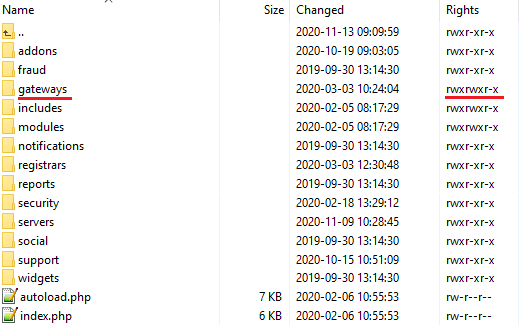
|
| 10. The next step is replacing 'invoicepdf.tpl' file with 'invoicepdf_rename.tpl' for each of the templates used. 'invoicepdf_rename.tpl' file is located in 'your_whmcs/templates/six/' folder. |
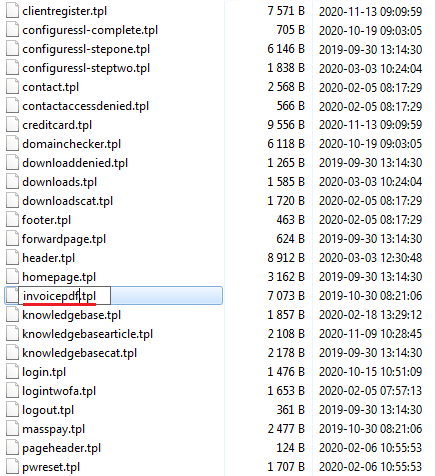
|
Integration Code
| 11. Now you can access your Multibrand For WHMCS module. Simply go to the 'Addons' → 'Multibrand'. But before you start using the module you still need to do an 'Integration Code'. It is required for correct branding and it should be done for all templates that you want to use with brands. |
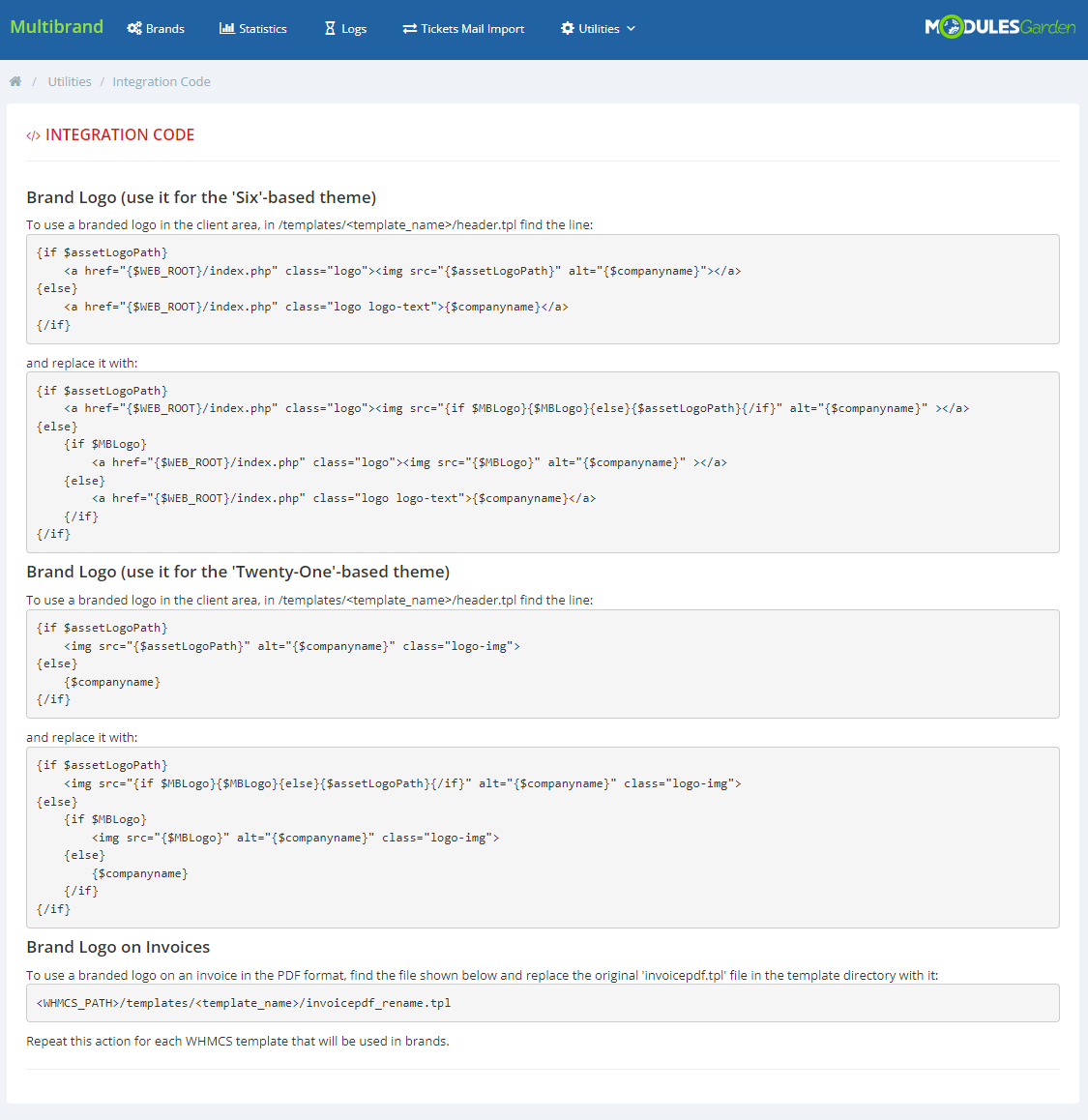
|
| 12. And that's all! You have now completed the installation of the module. |
Migration
| In the current beta 2.0.0 version, it is not possible to easily migrate data from 1.8.X to 2.X module version. Such migration functionality will be added in a future stable version. We are sorry for the inconvenience. |
Configuration and Management
| In this section we will show you how to properly set up and use Multibrand For WHMCS. |
Brands
| Under 'Brands' tab you can create and manage your brands using a single instance of WHMCS solution. |
New Brand
| Let's start by creating a new brand. For that purpose go to 'Brands' tab and press 'Add a new brand' |
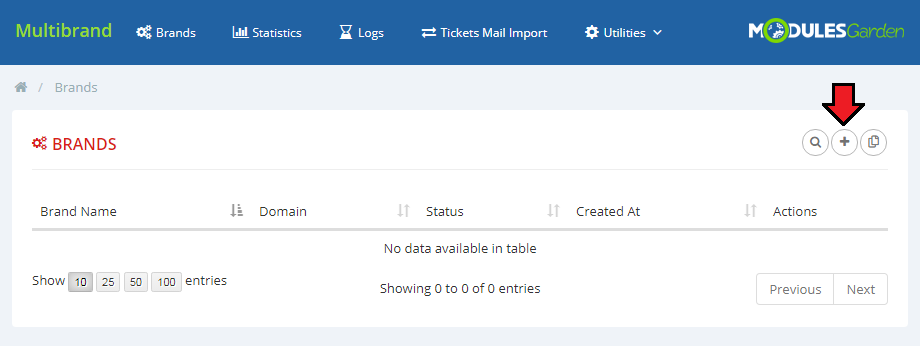
|
| Fill out brand's 'Name' and 'Domain' with desired values, and press 'Save' button. |
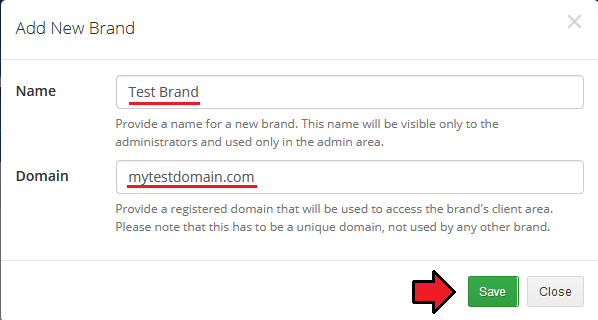
|
| Your first brand will be created. Next press the 'Edit' ' |
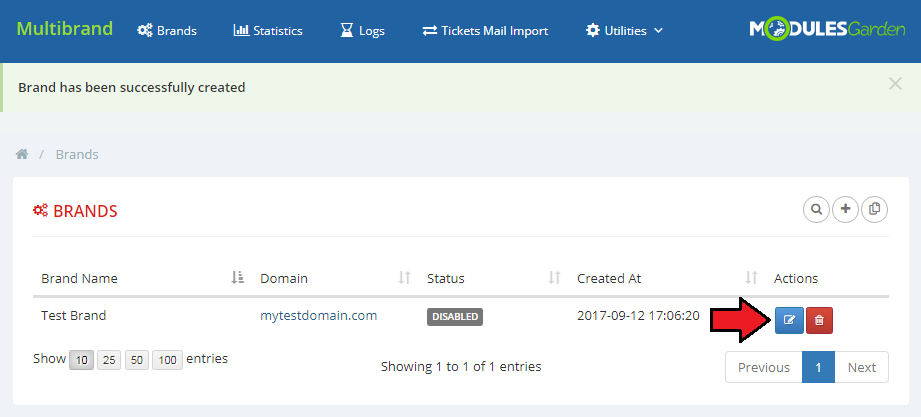
|
| You will be moved to the brand configuarion, where you can manage all brand's information and settings. |
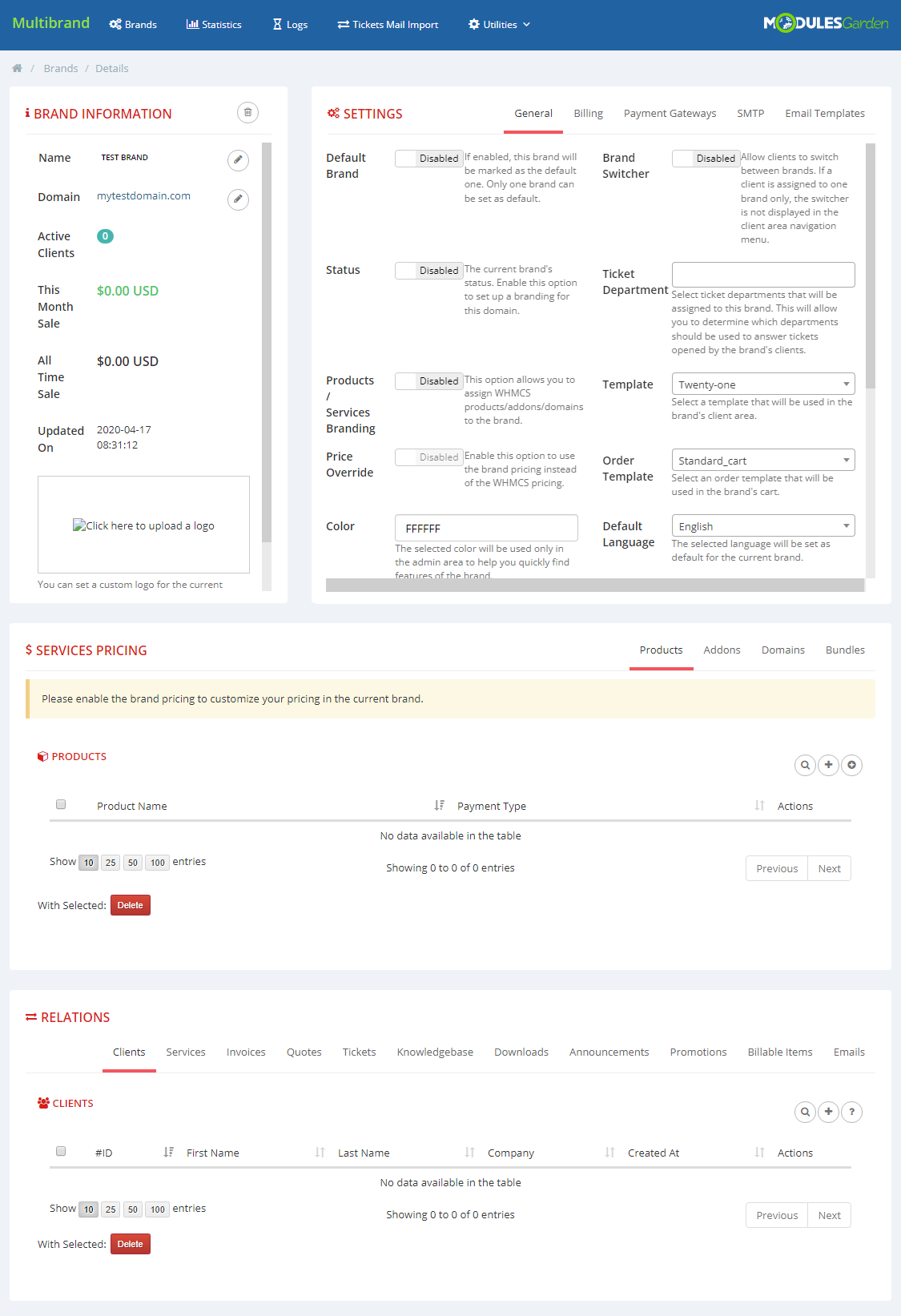
|
|
Note: Once the configuration of your brand is complete, will still need to set up a CNAME DNS record before the brand is published (status - enabled). |
Brand Information
| In the Brand Information window, you can edit the brand name, domain name and custom logo. In addition, you can see the current month revenue, total sale and last update of the brand. |
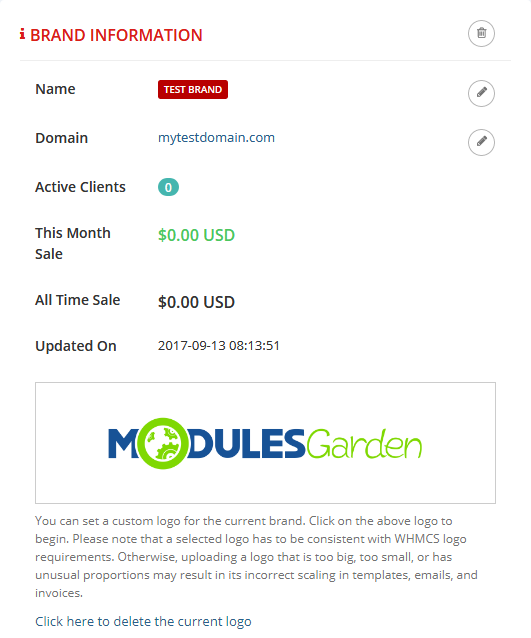
|
Settings
| In this window you will be able to configure all the most important settings of your brand, including billing, payment gateways, SMTP and email templates configuration. |
General
| In general settings you will configure the main brand options. First fill out brand's 'Email Address', 'Company Name' and 'TOS URL' . Next choose brand's 'Color', 'Ticket Departments' , 'Default Language', 'Template' and 'Order Template' . |
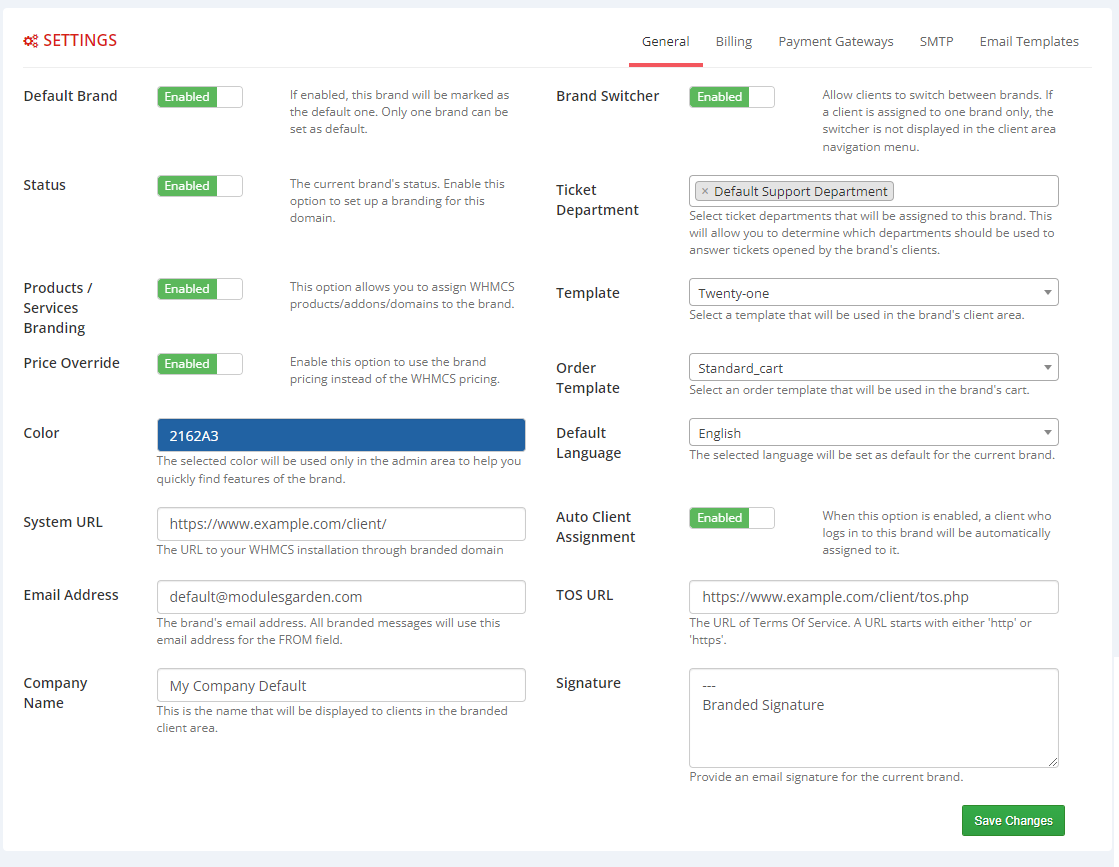
|
In billing settings you can configure the appearance of your invoices.
Note: Remember to do the 'Additional Settings' step during module installation to make the PDF invoices also branded. |
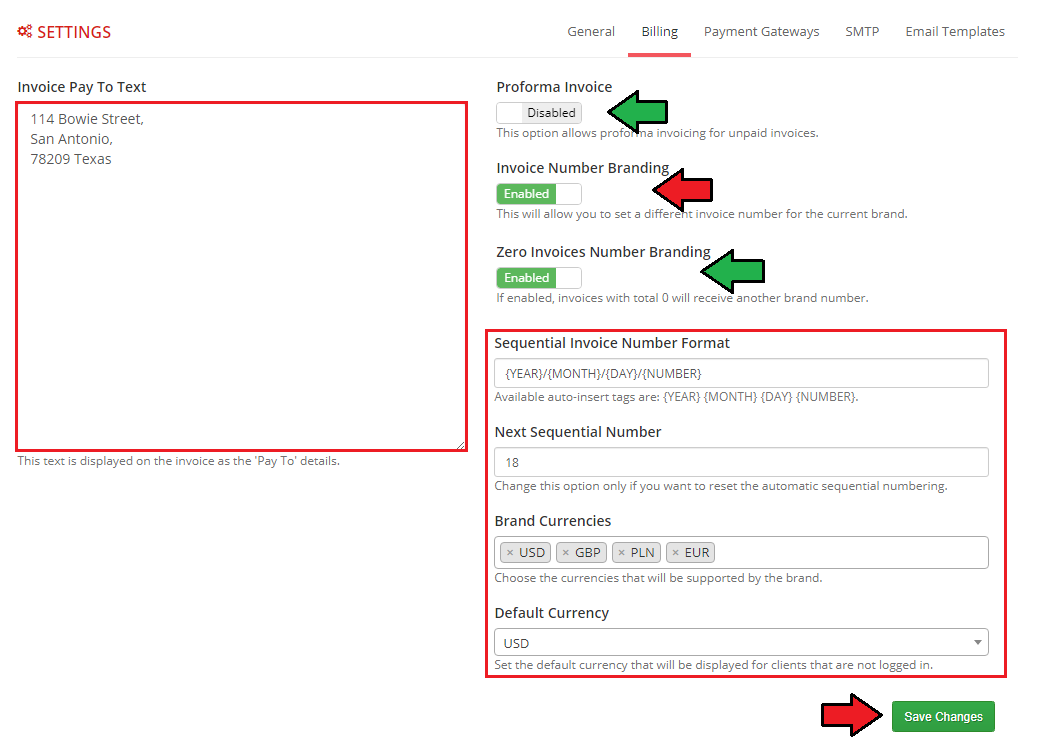
|
Payment Gateways
| This tab allows you to configure payment gateway for the brand which will work independently of that configured in WHMCS. You can check the list of currently available gates in the Feature List. |

|
| Next choose the desired gate from the list and press 'Confirm' button. |
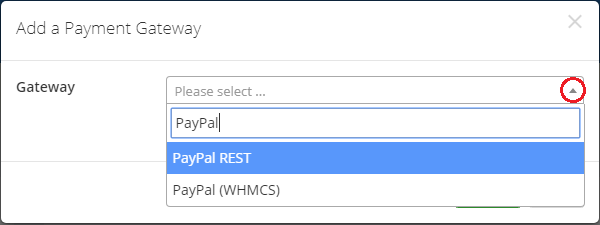
|
| Finally fill the payment gateway settings, according to the details received from the provider. Save the configuration and activate the gateway. |
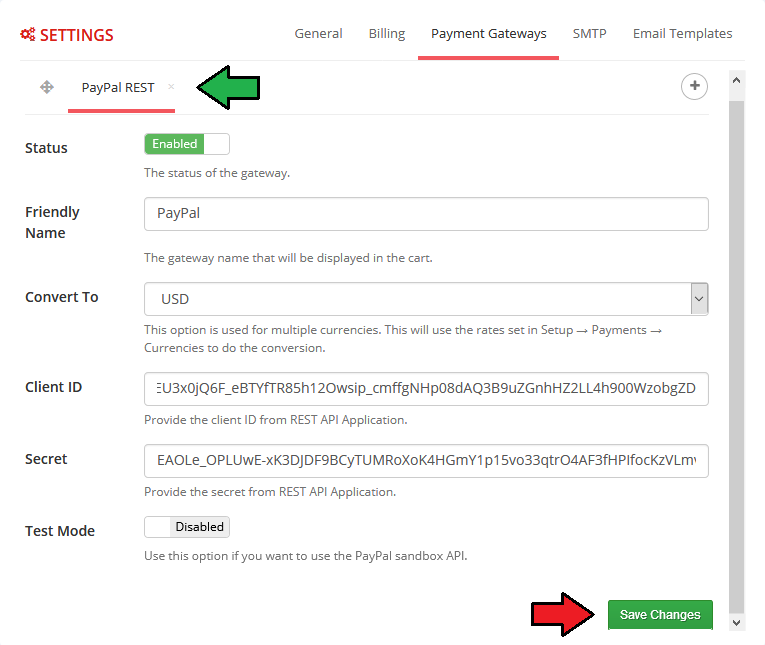
|
SMTP
| If you would like to use for this brand a different outgoing mail configuration than the main WHMCS settings, you can do so in this tab. In addition you can set custom CSS email styling and header and footer content. |
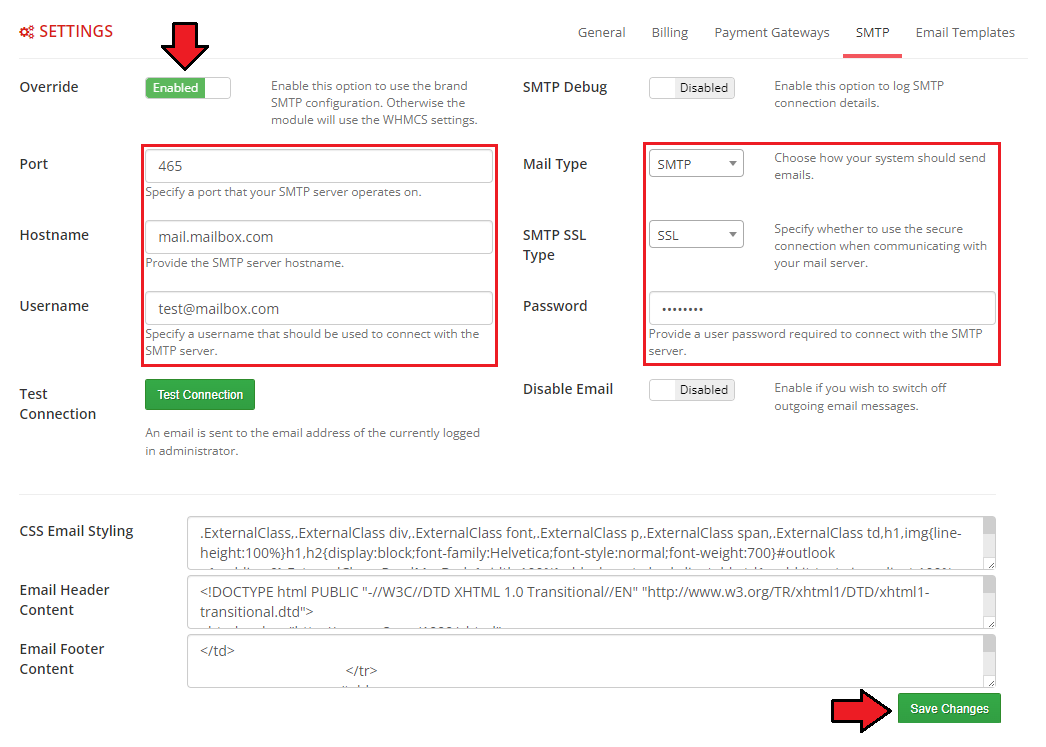
|
Email Templates
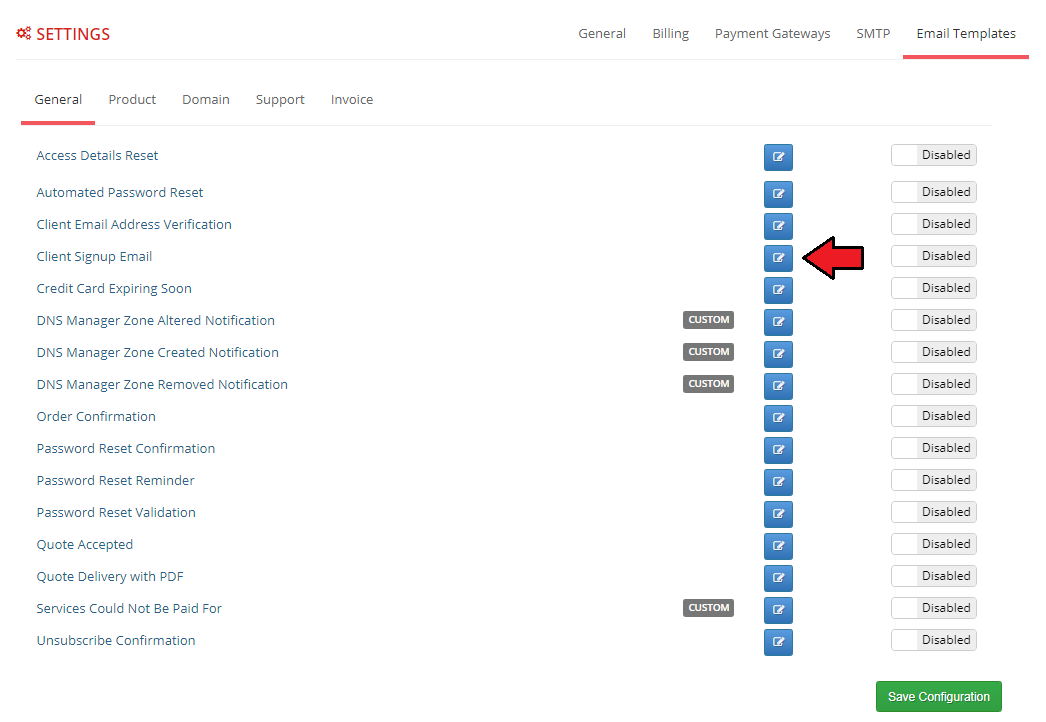
|
| Next, enter the desired subjecty and message content. You can also add them in several languages. In addition, you can also use the available merge fields tags. Save the changes after finishing. |
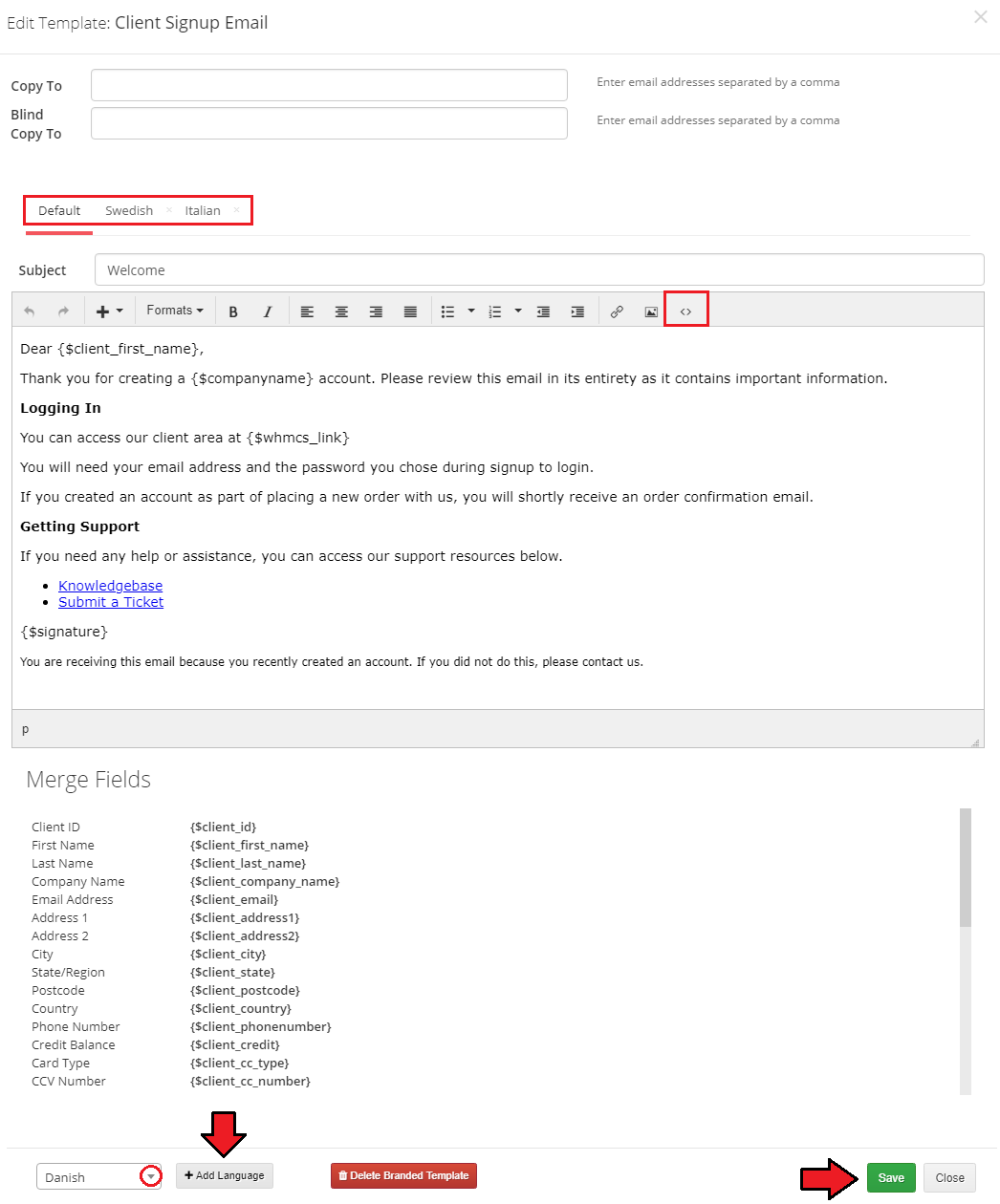
|
| Finally toggle edited template to enabled and save configuration. Next to the edited template you will see the 'Branded' label. If you would like to restore the default template, simply return to editing it and click the 'Delete Template' button. |
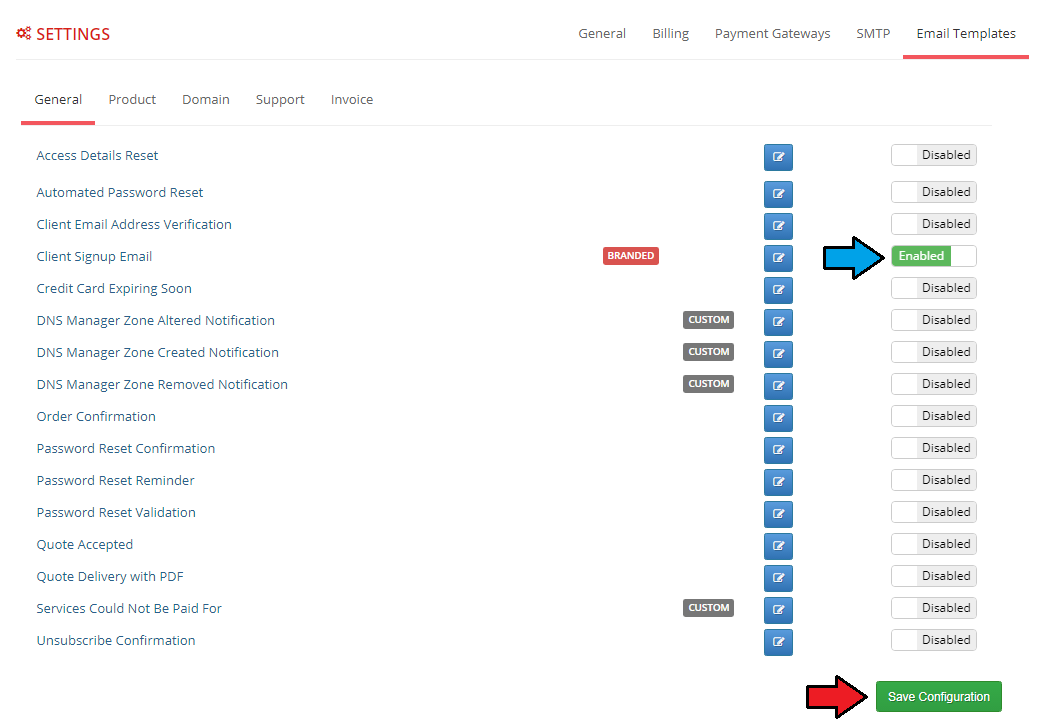
|
Services Pricing

|
| Select the product for which you want to set branded prices and click 'Save' . |
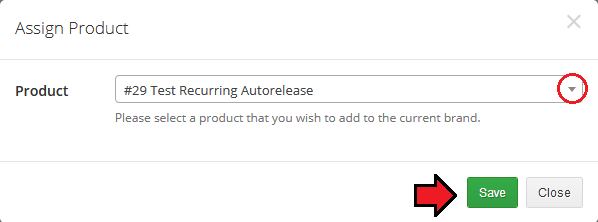
|
| Next open the pricing editor for the choosen product. |

|
| Here you can configure the desired prices in selected billing cycles and currencies. You can also automatically fill in amounts from the main product and update them refreshing the currencies rate. Note: Availability of billing cycles, prices and currencies to be edited depends on their main configuration in WHMCS. |
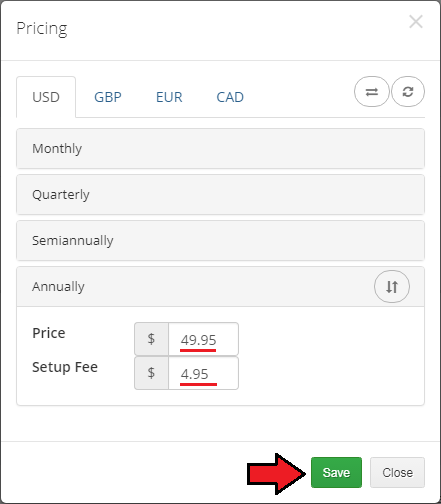
|
| From now on, the pricing for this product will be branded. In the same way, you can also configure pricing for the addons and domains. |
Relations
| In the relations section you can see which Clients, Services, Invoices, Knowledgebase, Downloads and Announcements are assigned to this brand. In addition, you can manually manage, assign and unassign selected items to brand. Note: Currently there is no possibility of mass management, assigning and unassigning selected items to the brand. This functionality will be implemented in future releases. |
Clients
| In the clients tab you can see customers who are assigned to the brand and the date on which they were assigned. Assignment takes place at the moment of client registration from the branded domain. You can also manually assign already existing customer to the brand or migrate to another. Note: If the customers are already registered on one of the other brands and trie to log in to another brand, their will also be automatically assigned to it. |
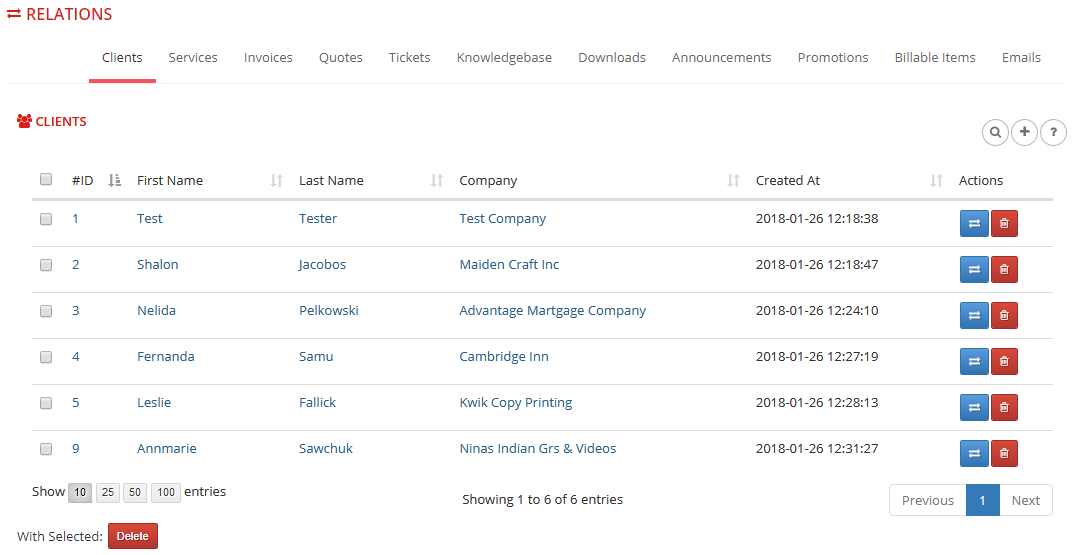
|
| To assign an exiting client to the brand, press 'Add' In the open popup select the customer you want to add to the brand and press 'Save' . |
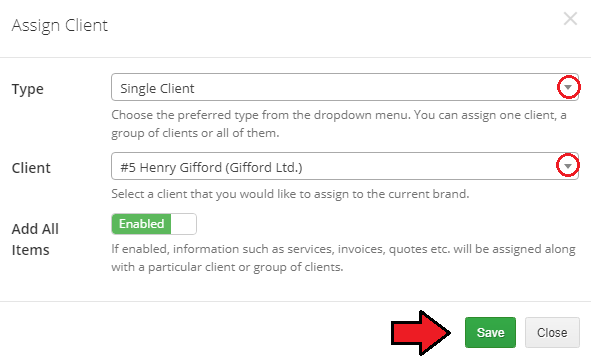
|
| You can also migrate the customer from this brand to another one. Click 'Migrate' |
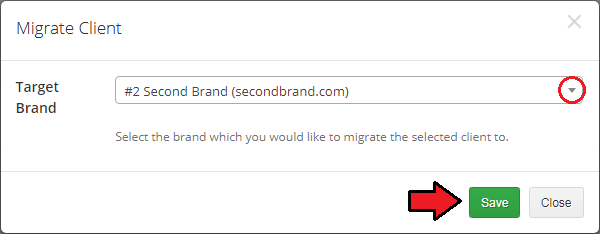
|
| And finally, if you want to delete the customer relationship with this brand, press the 'Delete' |
Services
| In the Services tab you can see which Products, Addons and Domains have a relation with this brand. These services are automatically added to the brand while ordering from the branded domain. |
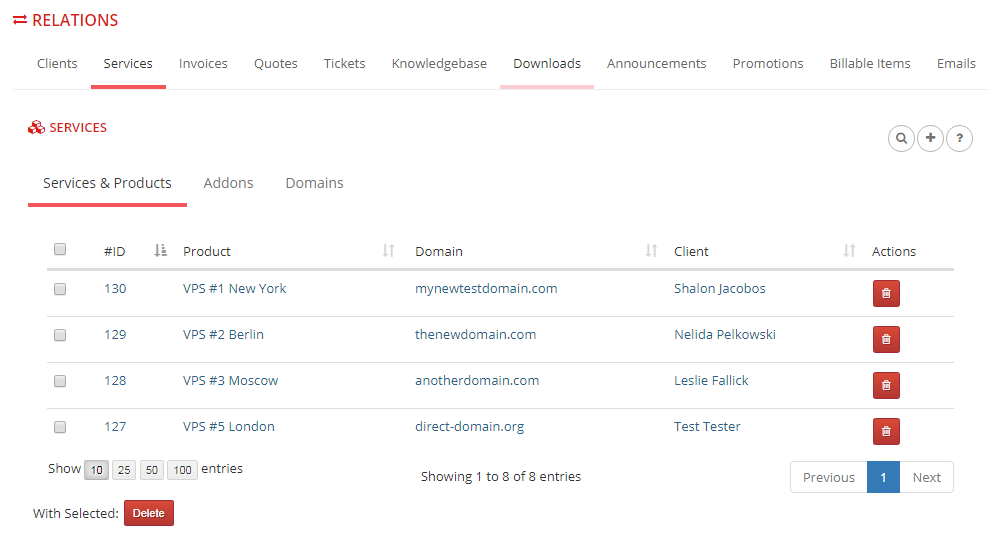
|
| You can also manually add a relation for a service that is not yet branded. Press 'Add' |
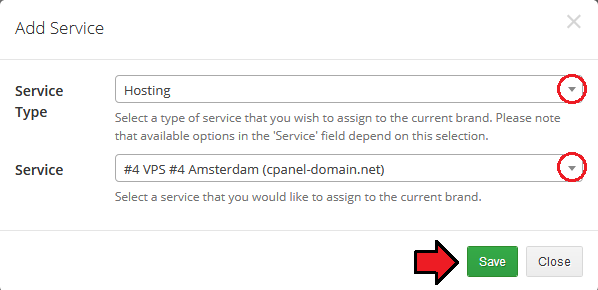
|
| And if you want to delete a service relation with the brand, press 'Delete' |
Invoices
| In this tab you can see which invoices have a relation with brand. These invoices are automatically added to the brand after the order has been created from branded domain. |
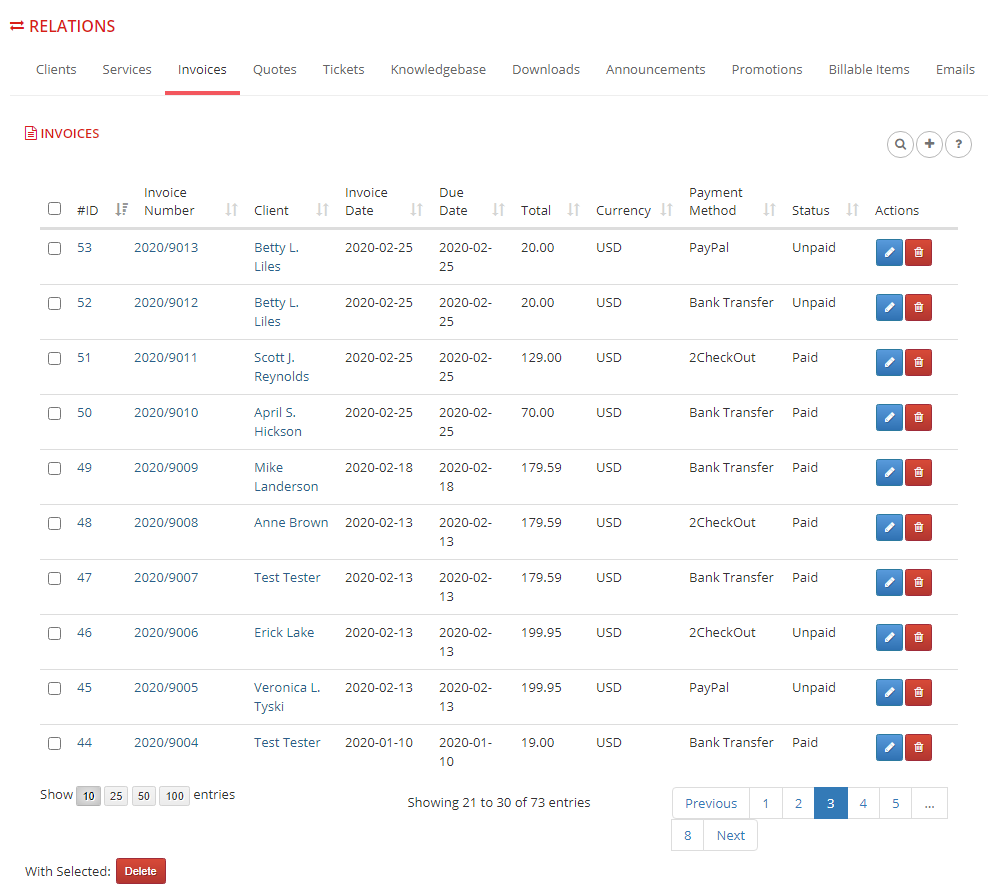
|
| You can also manually add a relation for the invoice that is not yet branded. Press 'Add' |
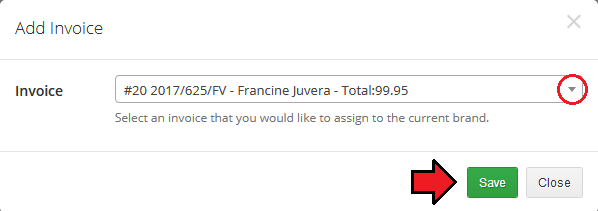
|
| And if you want to delete an invoice relation with the brand, press 'Delete' |
Tickets
| In this tab you can see which tickets have a relation with brand. These tickets are automatically branded after ticket has been opened in one of earlier branded departments. |
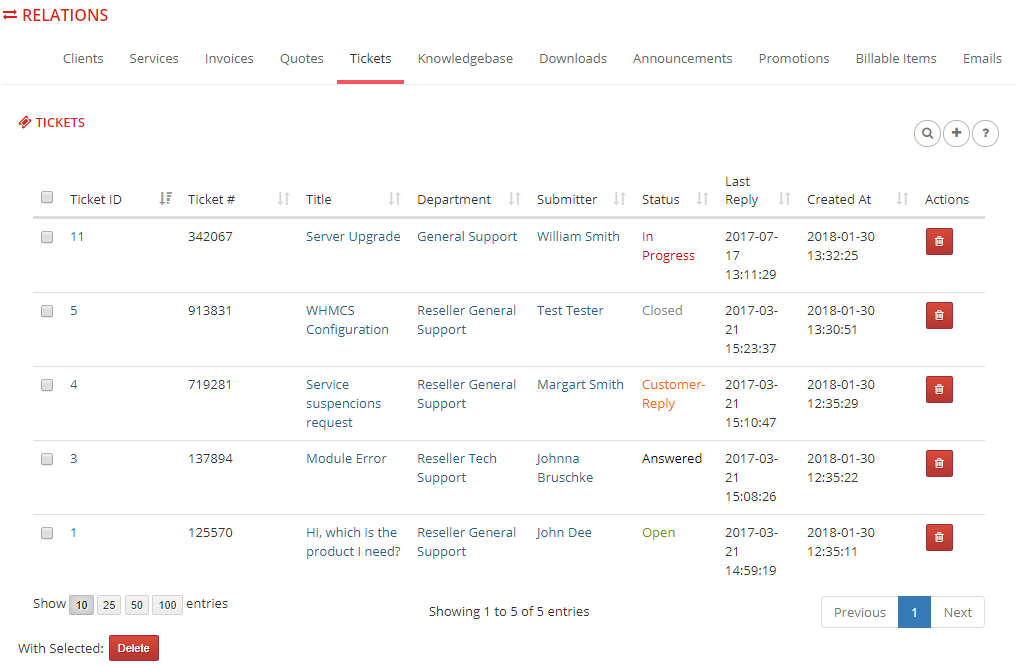
|
| You can also manually add a relation for the ticket that is not yet branded. Press 'Add' |
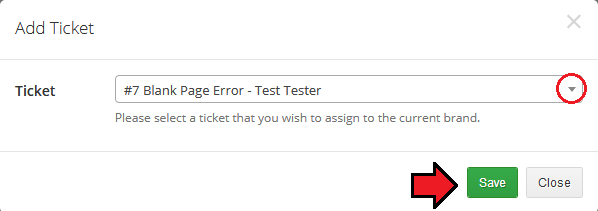
|
| And if you want to delete a ticket relation with the brand, press 'Delete' |
Knowledgebase
| In this tab you can see which your knowledgebase articles have a relation with brand. In addition, you can find here statistics of views, useful points, number of votes and date of assignment to the brand. |
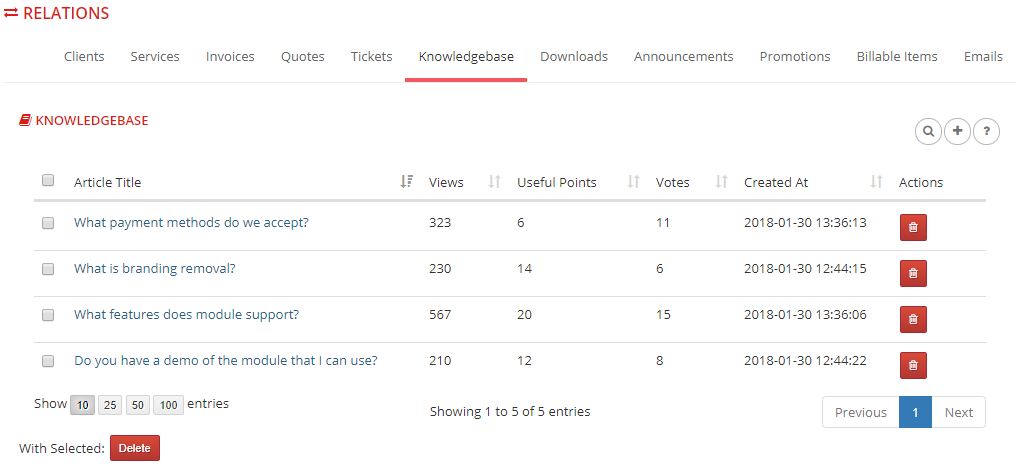
|
| To add a relation for the knowledgebase articles press 'Add' |
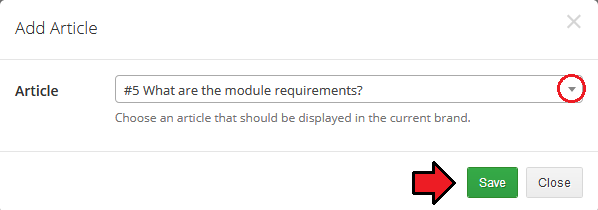
|
| And if you want to delete a knowledgebase article relation with the brand, press 'Delete' |
Downloads
| In this tab you can see which of your files available for download have a relation with brand. In addition, you can find here download category, type, number od downloads and date of assignment to the brand. |
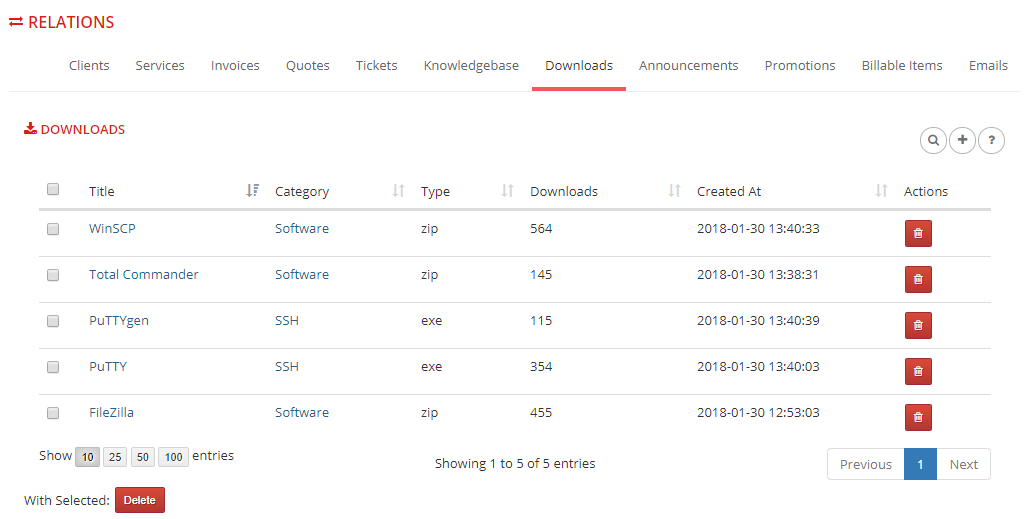
|
| To add a relation for the download press 'Add' |
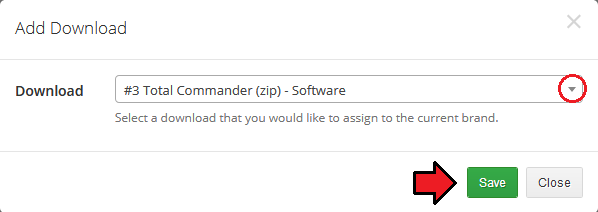
|
| And if you want to delete a download relation with the brand, press 'Delete' |
Announcements
| In this tab you can see which of your announcements have a relation with brand. In addition, you can find here date of announcement creation, assignment to the brand and published status. |
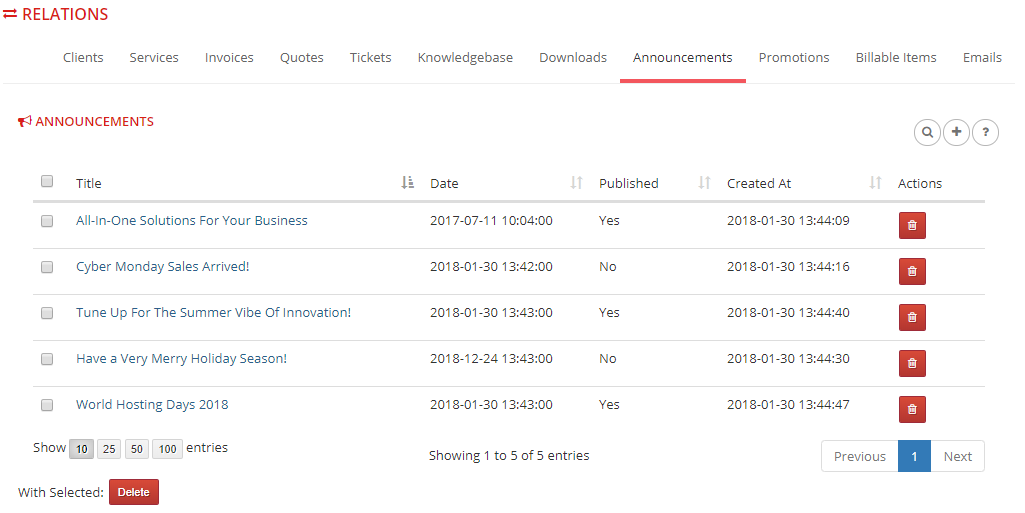
|
| To add a relation for the announcement press 'Add' |
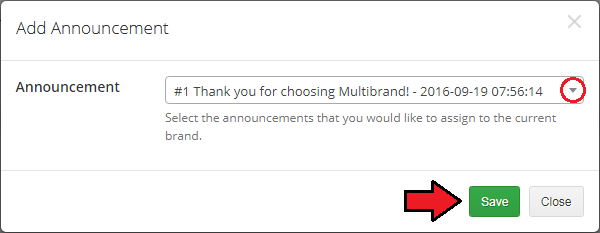
|
| And if you want to delete a announcement relation with the brand, press 'Delete' |
Statistics
| In the statistics section you will find sales charts of selected brands. You can filter them by date period and selected brands. |
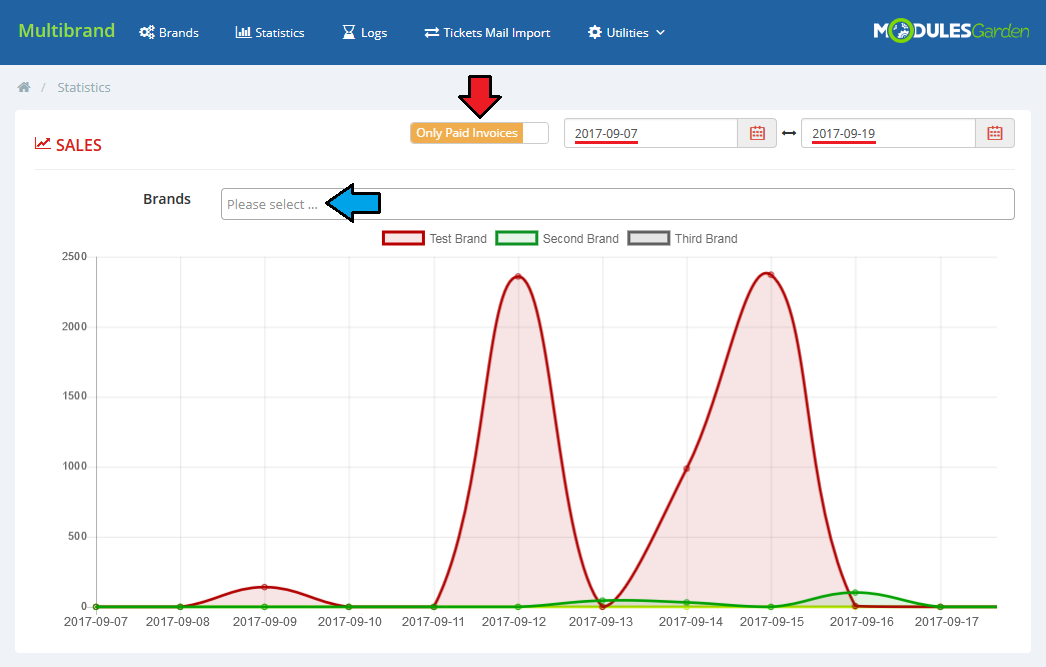
|
Logs
| Logs tab allows you to see the details of the actions that have been already performed. |
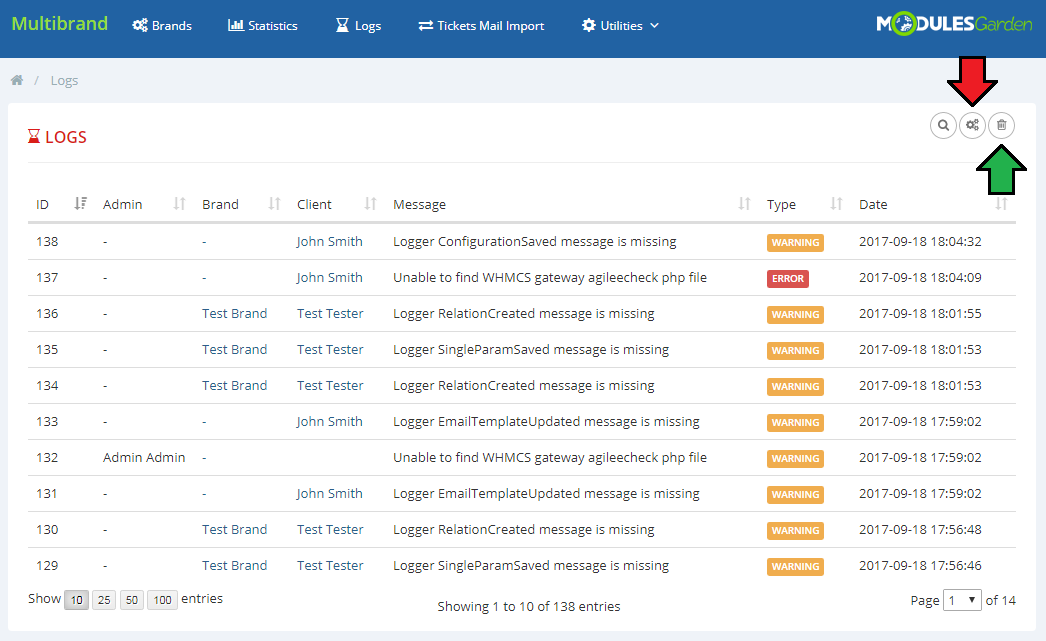
|
Branded Admin Area Functionalities
Membership In The Admin Area
| Multibrand For WHMCS makes management of WHMCS easier through introducing 'Brand Details' column. 'Brand Details' column informs you about membership of clients, invoices, tickets, orders or services to certain brand. |
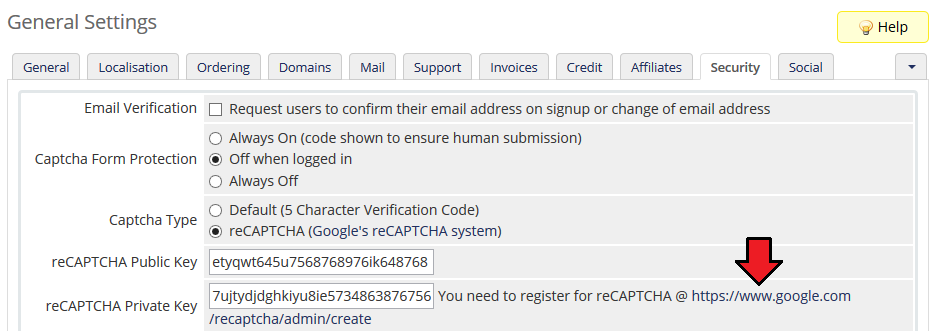
|
| In 'Order List' it looks similar. Through pressing a brand name, you will be moved directly to a report page of that brand. |
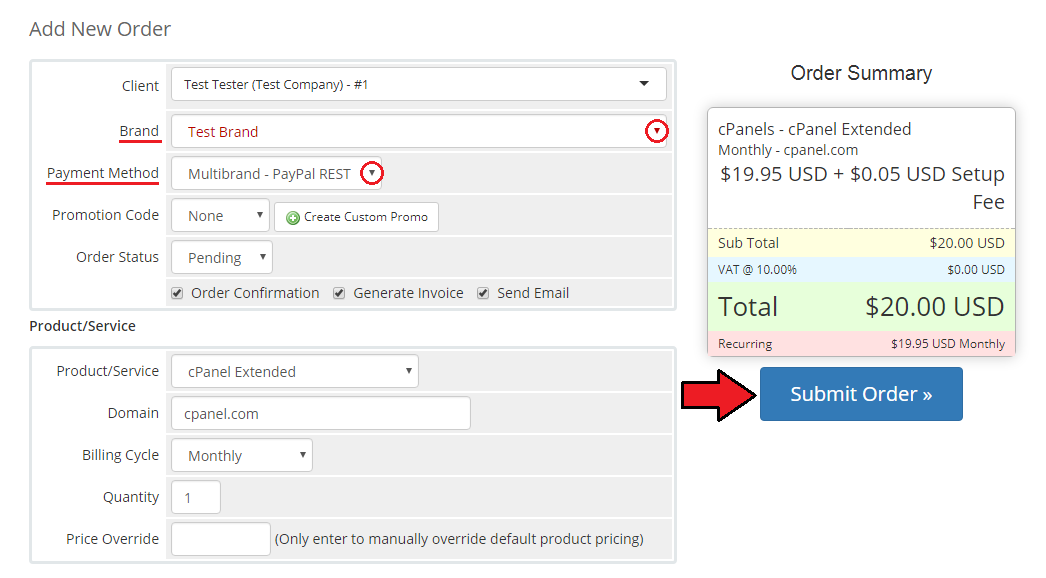
|
Invoices/Tickets/Quotes Creation From Admin Area
Announcements
Downloads
Knowledgebase
Branded Client Area Functionalities
Domains & CNAME Records Configuration
| In this section you will find guides on how to create CNAME record in popular control panels. For instance, if your branded domain is 'reseller.com' and domain with your WHMCS is 'whmcs.domain.com' , your CNAME will be 'www.reseller.com. CNAME whmcs.domain.com.'. |
| Domain used by each of the brands must be parked on the main domain. In case a domain cannot be parked or it is a subdomain, you must create CNAME records that will redirect from the brand domain to the main domain. Only when you have parked your domains you can move to setting CNAME records on your panels. See the tips below. |
cPanel
| 1. Log into your cPanel. |
| 2. Press 'Simple DNS Zone Editor' under 'Domains' section. |
| 3. Select the domain you wish to manage from the menu. Note: This step is required only if you own more than one domain. |
| 4. Fill in 'Name' and 'CNAME' record and press 'Add CNAME Record'. Note: To define record's TTL, you have to use 'Advanced DNS Zone Editor'. |
DirectAdmin
| 1. Log into your DirectAdmin. |
| 2. Click 'DNS Administration' . |
| 3. Afterwards, press select the desired domain. |
| 4. Fill in the full domain/subdomain into the CNAME record and press 'Add' next to it. Note: Do not forget to place a dot at the end. |
Plesk
| 1. Log into your Plesk panel. |
| 2. Press 'Domains' under 'Hosting Services' section. |
| 3. Find the domain to be edited, and click on the corresponding Control Panel link. Afterwards, proceed to 'Websites & Domains' tab and press 'DNS Settings' . |
| 4. Find the domain to be edited, and click on the corresponding Control Panel link. Afterwards, proceed to 'Websites & Domains' tab and press 'DNS Settings'. |
| 5. Add a new record or edit an existing one. |
| 6. Now, change the record type to 'CNAME' and fill in both 'Domain name' and 'Canonical name'. Finish by pressing 'Ok'. |
| Remember to restart your server once it is configured. |
SSL Certificate
| In this section you will find all information related to SSL certificate in WHMCS using Multibrand. If your branded domains or WHMCS domain are using SSL connection, all of them need to have the same certificate.
This is due the way in which WHMCS works. It is not the limitation of our module. require_once dirname(__FILE__).'/includes/MultiBrandSSLFixer.php';
$SSLFixer = new MultiBrandSSLFixer();
if($SSLFixer->shouldBeInSSL() || $SSLFixer->issetSystemSSLURL($db_host, $db_username, $db_password, $db_name))
{
if(! $SSLFixer->isInSSL())
{
$SSLFixer->forceRedirect(true);
}
}
else
{
if($SSLFixer->isInSSL())
{
$SSLFixer->forceRedirect(false);
}
}
|
cPanel
| Installing SSL certificate for domains managed from cPanel consists of the following steps: |
| 1. Log into your cPanel and press 'SSL/TSLS Manager' under 'Security' section. |
| 2. Click on 'Manage SSL sites' under 'Install and Manage SSL for your site (HTTPS)'. |
| 3a. (installing the certificate) Select the domain, paste certificate and private key and save the settings. |
| 3b. (using already installed certificate) Select it from 'Browse Certificates' and save the settings. |
Branding Limitations & Requirements
Limitations
| WHMCS
In this section we will list the parts of WHMCS which cannot be branded or may be working in an odd way.
|
| WHMCS Modules
In this section we will list the WHMCS modules which do not support multibranding or do not cooperate with Multibrand For WHMCS at all.
|
| Cloudflare
Cloudflare is a service that will mask your server IP address. |
Tips
| 1. The logo image is usually hard coded into the WHMCS template files. In order to use logo file provided in the 'Multibrand For WHMCS' module, find proper line at the template file and replace it with '{$logo}' variable. |
| 2. If you want Captcha security option to be displayed in your client area for all branded domains, you need to configure each of those domains in your Google Account as well. |
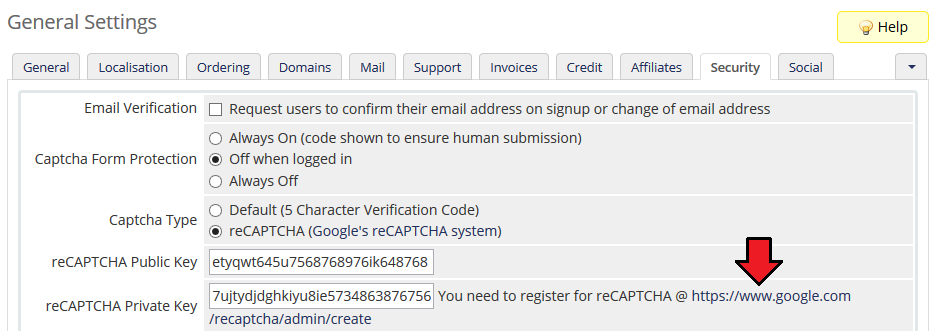
|